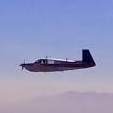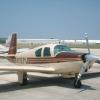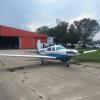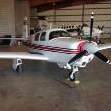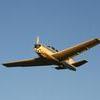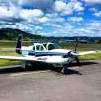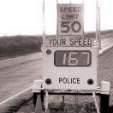Leaderboard
Popular Content
Showing content with the highest reputation on 04/17/2025 in all areas
-
+1 that that looks more like a prep issue. An existing leak or two weren't cleaned up during the process.5 points
-
There are a lot of G1000 airplanes of many different brands out there. Garmin still offers exchange units if a GDU goes bad. Plus there are salvage airplanes that are being parted out. I wouldn't lose any sleep over keeping the airplane flying for the next 20 years. What should be your biggest concern is whether the one you're looking at has been upgraded to WAAS. There were a much more limited number of GIA63W units made. If not you should definitely budget an extra $35,000 to spend immediately after purchase. Not doing so will not only limit your airplane but will seriously limit its marketability when that day comes.4 points
-
The only way to know if all cylinders are on the lean side of peak is to instrument all cylinders and then observe the temperatures.4 points
-
Chris Kevin Westbrook here I worked at Brittain call me 539-292-0474 and we can talk about the system!!!!3 points
-
I have posted here on MS my experience with the AeroCruze 100 (TT) autopilot. I installed it as an A&P No "approved" shop required for the install. It works fine in my D model for a basic VFR A/P and light IFR. It will do GPSS if wanted. Install is not difficult. Has "one button push" for straight and level flight great for inadvertent IMC. I removed a working Accutrak for the A/C 100. Much happier with the A/C 100. Can;t beat the price (in a Mooney) for a working A/P The choices are very limited. If you want a good A/P for a VFR Mooney ( or light IFR) go Aerocruze 100 If you do heavy IFR to mins all the time spend the money on Garmin $$$$$$$ LANCECASPER was writing as I was typing :-)3 points
-
This looks more like there was an ongoing leak while it got painted, than if you compare with G100UL paint problems.3 points
-
heres a little late follow up- this twitching has persisted. we rebuilt the alternator with no change. I do feel better about the new brushes and diode though, so not wasted- But, I tracked the ground and when I touched it, Black wire/ pink cover it fell off the bus... cleaned it, squeezed it, reattached. Seems to have fixed it. I did impress my local mechanic.... I told him any time I had an electrical problem with a car, it was always a ground issue... I have a nice vid of the ammeter before and after, but don't know how to load it here Rob3 points
-
The AD allows for inspection and re-use of the clamp until July 17. There's a procedure in the AD for it that involves looking at it with 10x magnification, and as long as there are no cracks and as long as the band's inner parts do not touch when tightened to the proper torque spec, it can be placed back in service. This inspection becomes required after 500 hours in service so maybe your A&P is a little confused on what "timed out" means. I've attached the AD. I previously talked with some A&P's who said they are in fact inspecting and reusing clamps that pass, since new ones are not available. AD_2023-09-09-compressed.pdf2 points
-
In this area, we are typically talking about revocable family trusts in which the “settlor’ (the person who creates the trust and adds property to it) is also the beneficiary and can undo the trust at any time while alive. Like any revocable family trust, its two major functions are (1) avoiding probate and (2) providing for assert management if you are incapacitated. I’m not aware of any state in which it provides any liability protection. I suspect that, kind of like LLCs, lots of people think it provides personal liability protection for bad things we do, but it doesn’t. Whether this or any other estate/financial planning mechanism provide you any benefit at all is a discussion between you and a legal professional.2 points
-
2 points
-
1 point
-
I hadn't seen that site before, looks like a great resource, thanks for sharing!1 point
-
1 point
-
Like many have mentioned in other PC related posts on Mooneyspace, Kevin Westbrook is the remaining most knowledgable person regarding the Brittain Autopilots. He's a member here. If you decide to troubleshoot or restore, he should be able to help even if over the phone. He's helped me keep mine operational. As a mechanical engineer by degree, and someone who loathes software updates, it's a design I still admire. There are schematics available if you wanted to start with basic troubleshooting and check your vacuum lines and servo boots for leaks. https://mooneyspace.com/profile/48565-kevin-westbrook/1 point
-
I literally had nightmares about this scenario and I did not have any active leaks, nor history of them. I waffled for a few months to reseal or not I eventually gave in and they are getting sealed right now, paint to follow as soon as they are done1 point
-
Based on the photo the runway at South Texas International needs some repaving, and I'd recommend the airport fence be moved a bit farther away from the runway1 point
-
I’d recommend venting the tank first before disconnecting that line, especially since it’s almost full. Even if the valve is shut, there could still be some pressure. Better to be safe than sorry.1 point
-
I'm with you. I have tons of PDFs for various airplanes and engines (not all Mooney), but for my equipment, I prefer paper.1 point
-
Sorry to hear that. Go to continental.aero and verify the part number you need for your particular engine serial number. Order one from Airpower.com. They show backordered but are shipping them as they get them from Boeing, who makes them. Took me 4 months to get one but I got it this month. Call RAM aircraft and see if they will sell you one of theirs. Consult your A&P to make sure they will install it. There may be issues with their PMA, which may or may not include the TSIO-360-GB/LB/MB/SB, depending on who you ask, though it's approved for the other models of the TSIO-360 used in the Piper Seneca. They may also be sold out again. Be prepared to spend $850/1300 for whatever you get. Hope you get one soon.1 point
-
Your fuel injection system needs to be tuned badly by an A&P that knows how to do it or can reasonably follow the instructions to make it work. Once one part is tuned, it whacks another part so it is a constant back and forth until it's perfect. Mine will now idle correctly at 600 rpm.1 point
-
How about a spelling change (thanks autocorrect) SOLE to SOUL I wasn't talking to the fishes :-)1 point
-
I see no reason to burn extra fuel. I get around 134 - 135 IAS on 10.1 GPH. 5 knots for 2.5 GPH??? Nope.1 point
-
Just for fun 2 years ago I did Tampa (Sun n Fun) to Santa Fe NM at 1500 AGL all the way and didn't talk to a sole unless I landed at a towered airport. Did 5.3 hr east bound ONCE but never again. Had 1+15 left in gas. Way too long to sit.1 point
-
The wind and direction of flight usually determine my altitude. Heading west- usually lower to avoid the winds up high. At least 4,000 though. Often 120-130 knots G.S., sometimes 110 (ugh). Coming back home, 11,500, 2500, 7.5 gph, 160+ knots G.S. Did non-stop Santa Fe to Tuscaloosa last year in 6.1 hours.1 point
-
I'm generally at 7500-10K when traveling, unless the headwinds are strong. My C runs out of climbing oomph . . .1 point
-
1 point
-
We are finalizing some of the details and will make an official announcement end the end of the week. September 12-13 is the planned weekend. Cheers, Dan1 point
-
I have an LB and a JPI930 but in all other respects about the same as yours. I don't think you are running ROP at all at 11 GPH and 29". In my engine, ROP at that MP and 2450 RPM would be 13+ something GPH to get to about 125 degrees ROP. Maybe the problem is, what makes you think you are running LOP at that setting? Here is what I suspect. I don't know your engine monitor, but using my JPI the standard instructions are to start by running the engine well on the ROP side, put the monitor in lean of peak mode for leaning, and then lean out until the monitor tells you that you are LOP. Select your degrees LOP from the monitor and there you are. The problem is that this method is completely wrong for the 231. Lean of Peak and Rich of Peak are air/fuel ratio settings. They are not power settings although they can be used to make a power setting. The leaning mechanism in the monitors I am familiar with are all algorithms, in other words, our aircraft have no sensors that directly measure the air/fuel ratio the engine is running at. The algorithms I am familiar with all make the same assumptions, (1) that you start on the Rich of Peak side, and (2) that while you are leaning the fuel all other things remain equal, most importantly, that the manifold pressure remains where you set it when you started your leaning process. This works in the 252 and other turbo Mooneys that have truly automatic wastegate controllers that maintain MP where you set it while you lean out the fuel. The problem with the 231, even with the Merlin, is that MP does not remain where you set it if you start reducing the fuel flow. The Merlin is a differential controller, not a density controller. There are several things going on. One, there is an interlink in the TSIO360 engine so that if you set a power setting of, let's say, 30" and 13.3 GPH, and then decide you want to slow to approach speed, you can pull the MP back and the interlink automatically reduces the fuel flow to maintain roughly the same air/fuel ratio that you had at 30/13.3. Notice that when you do this the air/fuel ratio is not changing, you are still running ROP even though the EGTs have all dropped from their starting point. This interlink in my experience does not work as effectively when you pull the fuel back as it does when you pull the MP back, but it does work. So the MP is dropping as you lean the fuel. Second, as the engine begins to produce less power the turbo produces less compression, further causing the MP to drop as you pull the fuel back. These things are causing you to violate the basic assumption of the leaning algorithm - that MP stays steady while fuel flow is reduced, thus changing the air/fuel ratio from a rich setting to a lean setting. In short, if you do your leaning this way all you have done is reduce power, but you have done little to change the air/fuel ratio. The engine monitor will most likely detect a drop in EGT in all the cylinders, which is their signal to tell you that you are running lean of peak when the monitor really has no idea where you are running any longer. We just did a lean test on my new engine. The proscribed method is to start at an approximately 65% Rich of Peak setting, then slowly lean in increments of .3 GPH and record the EGT's on each cylinder. We chose 24.8 MP, 2400 RPMs, and 9.5 GPH, which I know from experience is a ROP setting. A move of .3 GPH did not change the MP much but a move of .6 changed it by a few tenths, enough that for about every two moves of .3 GPH we had to bump the MP back up a little. If you make a relatively big fuel move, like 11 GPH to 9.5 GPH you will get a fairly large MP decrease - on the order of 1" or more - and that invalidates the lean test you think you are running. If it helps - if I want to fly at least 125 degrees ROP in my engine at an MP of 29", I need a fuel flow of 13.3 GPH to 13.5 GPH. A setting of 11 GPH is going to be a LOP setting most likely, but not a very LOP setting at 29". At 29" you are probably just a few degrees LOP, pretty close to peak. Anything in the 12's is going to be a Peak setting or worse, around 50 degrees rich of peak. There is more to it, but based on what I would see in my engine at those power settings your 9.5 setting is probably a 60-65% power LOP setting and your 11 GPH setting is probably not lean of peak at all or if it is, it is just barely lean of peak, but it is not rich of peak. You are running too close to peak.1 point
-
I suspect you’re a little too much LOP which is causing the stumbling. Id recommend starting LOP to try a setting that will get you 65% so you can’t hurt anything and then play with it from there. You just need the FF for your engine. As long as you’re on the lean side of peak, FF is the only determinant of power. So your engine, 65% is 210hp x .65% = 136.5. Divided by 13.7 gives you a ff of ~10gph. Try that ff at say 27/2300 or so maybe 28/2300 if it will run smoothly. set the mp/rpm, then big mix pull to 10, then reset the others back to 27/2300 or 28/2300 as required. Then slowly richen until peak to see how far lean of peak you were (and then set back to 10gph). At 65%, you can shoot for closer to peak, maybe 20-40degrees. If it’s too lean, pull throttle back just a little as that’s what is controlling the air into the cylinders. you should see much cooler cylinders.1 point
-
I'm in the middle of a plastic repair & restore process right now. I recommend S.E.M. products, specifically their soap, adhesion promoter & paint. My results have been great. Just follow their directions. By all means get a respirator AND goggles because the adhesion promoter & paint fumes are horrible. You'll need nitrile (or neoprene) gloves and unless you want your finger to cramp up get a "Can Gun" aerosol spray trigger from Aircraft Spruce. Paint on a calm day ideally between 70* to 85*F. It's best to apply several very light coats (up to 7 or 8 in my case). It dries very fast but wait the directed amount of time between coats. If you've never spray painted before watch a YouTube video for proper technique. It's not difficult but I practiced on an old cardboard box just 3 times until I had it perfected. Leave your finished work to cure for a day or two before handling. Most if not all odors will have dissipated by then unless the ambient temperatures have been cool. Fun Facts - S.E.M. paint is expensive but totally worth it. IIRC McFarlane sells a limited number of colors and had it for a good price. Unfortunately, not the specific color I wanted. O'Relly Auto Parts was pricey and had supply chain issues. Amazon saved the day and was by far the least expensive but be aware they don't have returns on paint due to it being HazMat. Calculate your square footage necessary and order conservatively knowing you can always order more if needed. For cracks in the plastic, I initially tried "Satellite City" instant glue, specifically their "Hot Stuff" and "Super 'T'" product. It has the viscosity of water which I found difficult to control and the results were not what I'd hoped for. I ended up using 7 Quarical Easy ABS Repair Tips for Easy Plastic Solutions which is an all-in-one pre-mixed ABS solution which proved to be outstanding. My headliner had some very bad cracks, splits & holes The ABS resin resembles tar and is applied from the back so no will ever see it. Time will tell if it holds up but I'm very optimistic. If you need more specifics just send me a DM. It'd be easier to explain it on the phone. BTW great looking Mooney. Wow!!!1 point
-
My ‘64 M20E had engine failure in flight a couple of months ago. No warning, in cruise at 4500’ there was a loud “POP” followed by sad engine noises and partial power. After the ensuing forced landing at nearest airport (itself quite a story) we identified the proximate cause, #3 exhaust valve lost its head.0 points

